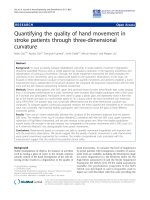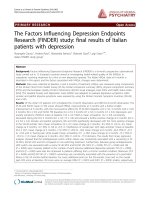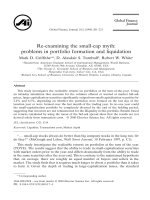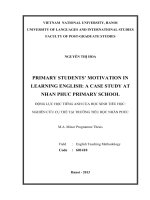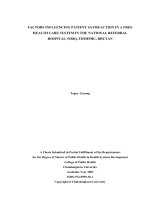Examining the factors influencing WH movement in singapore english a discourse perspective
Bạn đang xem bản rút gọn của tài liệu. Xem và tải ngay bản đầy đủ của tài liệu tại đây (571.64 KB, 96 trang )
EXAMINING THE FACTORS INFLUENCING WH-MOVEMENT IN
SINGAPORE ENGLISH: A DISCOURSE PERSPECTIVE
TAN GIM YONG
B. Arts. (Hons), NUS
A THESIS SUBMITTED FOR THE DEGREE OF
THE MASTER OF ARTS
DEPARTMENT OF ENGLISH LANGUAGE AND LITERATURE
NATIONAL UNIVERSITY OF SINGAPORE
2011
Acknowledgements
I would like to thank Dr Bao Zhiming for his kind and helpful assistance throughout the
whole course of my work. His insights have been both inspiring and encouraging.
2
Table of Contents
1. Chapter 1: Introduction
2. Chapter 2: WH-fronting
3. Chapter 3: WH-in situ
4. Chapter 4: Conclusion
3
Summary
In Standard English, WH-movement is used to form interrogatives from their declarative
forms. However, it is noted that Singapore English contains interrogatives that involve both
WH-movement and WH-in situ. Works in the literature recognize that WH-in situ can
sometimes occur in Singapore English, but falls short of providing a viable explanation. The
occurrence of instances of WH-in situ and WH-movement is generally taken to be random.
This paper seeks to explain the preference of WH-movement in certain situations over WHin situ and vice versa. In order to do that, a background understanding of the language
ecology of Singapore is needed. Upon establishing the strong influence that substrate
languages like Mandarin, Hokkien and Cantonese have on Singapore English and that the
superstrate language is Standard English, it is found that discourse plays a major role in
deciding the preference of either of the two forms. Using the ICE-SIN corpus as the primary
data and Google search results as supplementary data, a comprehensive analysis is done,
examining in great detail the way WH-in situ and WH-movement are used in Singapore
English.
4
Chapter 1:
INTRODUCTION
1.1 Singapore English
The English used in Singapore had been widely documented in the literature under
different labels such as Singapore Colloquial English (SCE) and Singapore English (SgE).
Contrary to the academic perspective of the English language used in Singapore as a variety
of English, the government had insisted on using exonormative standards, preferring to
regard the supposed varietal features of the English in Singapore as learners’ errorsevident from the government’s attempts to weed out this local variety through campaigns
such as the “Speak Good English Movement”. The population of English language users in
Singapore is diverse, ranging from people who speak Standard Singapore English to those
who only have a basic command of English (Pakir, 1991). This paper will see the typology
of the English in Singapore on a continuum with different “lects”. Pakir (1991:168) points
out this continuum in her “expanding triangles model”, suggesting that there is “much more
complexity and many more different levels of English in Singapore” than a mere dichotomy
of Standard Singapore English and Singapore Colloquial English. Her “expanding triangles
model” captures “an increasing English-speaking base population and two distinctive
English speech clines in Singapore, graded on formality and proficiency considerations”
(Pakir, 1991:169). This model will classify the learner’s “errors” mentioned earlier as part
of the basilect, with heavy “proficiency considerations” limiting the learners’ production of
English constructions while the Standard Singapore English users’ variety (that
approximates closely to Standard English in grammar) will form the acrolect. The mesolect
is the in-between, likely to contain elements of the learner’s “errors”, with Standard
5
Singapore English as the anchor. In this paper, Singapore Colloquial English (henceforth,
SCE) will refer to the mesolect, “mainly because this is the variety on which most studies of
SE (Singapore English) have been based and the speech that the bulk of the data in the
GSSEC (Grammar of Spoken Singapore English Corpus) corpus is most characteristic of”
(Ansaldo, 2004:129). The GSSEC was later incorporated into the ICE-SIN corpus. Having
said that, Ansaldo (2004:129) also acknowledged that there could be other “varieties of SE,
more acrolectal, i.e. more modeled on English (Standard English), as well as more
basilectal, i.e. almost entirely modeled on non-English syntax.” These will not be covered in
the scope of this paper.
1.2 Influence of background languages on SCE
It is important to consider the linguistic ecology of Singapore before accounting for
the language features in SCE. Bao (2001:280) highlights the three important factors in the
linguistic ecology of Singapore: the “population change in historical context”, “the local
languages of the main segments of the population” and the “lingua francas of Singapore’s
multi-lingual and multi-ethnic community”. The importance of these factors were also
reflected in Lim and Foley’s work (2004:2), who stated that “in a small island of 4 million
people made up of 76.8% Chinese, 13.9% Malay, 7.9 % Indian and 1.4% persons of other
races (Leow, 2001), it may seem strange that English, the language of the colonial rulers,
should have the dominance and scope that it commands in the day-to-day life of
Singaporeans. The situation is partly the legacy of colonial history and partly the effect of
post-independence policies in which English has been recognized as a resource to increase
the country’s rate of economic and social development.” These demographic figures are a
6
reflection of the British administration, who decided to preserve the ethnically-based
division that “[constituted] the cultural logic of Singapore’s “multiracialism” (Benjamin,
1976)” (Lim & Foley, 2004:2). The socio-historical dynamics of these ethnic groups is
critical to understanding the language development, and subsequently the formation of
SCE.
Among the various ethnic groups, the Peranakans were the earliest English speakers
and it has been argued that their vernacular, Baba or Bazaar Malay, had been influential in
the development of English in Singapore (c.f. Lim, forthcoming, 1995). As such, “it is clear
that the type of Malay that influenced the development of SE (Singapore English) must have
been such a restructured variety of Malay and not standard or High Malay (e.g. Bazaar
Malay, cf. Gupta, 1998b)” (Ansaldo, 2004:131). To sum up, the “local languages of the main
segments of the population”, namely restructured Malay (Bazaar or Baba Malay) and the
Chinese dialects, Hokkien, Teochew and Cantonese, form the substrate languages of
Singapore while the superstrate language is English (cf. Ansaldo, 2004:132). Among the
substrate languages, Malay and Tamil have “negligible contribution of the grammar of
Singapore English” (Bao, 2001, c.f. Platt & Weber 1980). While restructured Malay may
have played some part in contributing to the early development of the English in Singapore,
the variety itself has phased out in local usage over the course of Singapore’s independence
and since then, the development of English in Singapore has undergone various changes to
its current form, SCE. In the light of this paper’s focus on a discourse perspective on WHmovement in SCE, influences from restructured Malay will not be discussed. For this
reason, the focus of the substrate languages will be largely on Mandarin and Chinese
dialects, namely Hokkien and Cantonese.
7
1.3 SCE WH-question formation
In Standard English, WH-questions are derived from their corresponding
declarative forms by WH-movement, typically involving WH-fronting and subject auxiliary
inversion (as well as do-insertion where auxiliary verbs are absent). In SCE, WH-questions
can be derived by WH-fronting or WH-in situ. These two different processes can be
illustrated in the examples below:
WH-fronting
Declarative: He is going to town.
Interrogative: Where he going?
Declarative: He is reading a book.
Interrogative: What he reading?
Declarative: He is going to town.
Interrogative: He is going where?
WH-in situ
Declarative: He is reading a book.
Interrogative: He is reading what?
Previous research has shown that there is variable fronting in WH-question formation in
SCE (Tay, 1979; Platt, Weber and Ho, 1984; Kwan-Kerry, 1986; Wee, 1987; Gupta, 1990;
Bao, 2001). Attempts had been made to account for the syntactic formation of the WH-
questions, but there has been no satisfactory accounts to explain the choice of the
processes (whether Wh-fronting or WH-in situ) used in WH-question formations. For
example, the WH-questions “What he reading?” and “He reading what?” shown above are
both acceptable in SCE, but it is unclear under what circumstances would one be preferred
over the other.
8
This paper attempts to explain the circumstances under which the WH-fronted
forms and the WH-in situ forms are preferred. Given the importance of the influence of the
background languages on SCE, the various SCE WH-forms are compared with that of the
background languages to examine whether the preferences of certain WH-forms could be
motivated by the influence of background languages. On top of that, the choice of the
preferred WH-forms because of the influence of background languages becomes all the
more apparent when studied from the perspective of discourse.
1.4 Methodology
This research will be primarily based on the ICE-SIN corpus and supplemented by
data collected by Ho (1999) and web data from the Google search engine. Data apart from
the ICE-SIN corpus is used because the corpus may not entirely capture all the uses of SCE.
In instances where the aspect of language used analysed by the paper is unavailable in the
ICE-SIN corpus, data collected by Ho (1999) and web data from Google (SG) will be useful
supplements. Web data from the Google search engine are used because the Internet
medium allows greater freedom for SCE usage, unlike mainstream publications, where SCE
may be “corrected” to approximate Standard English. It also provides more recent and up-
to-date data for analysis. Mair (2007) rightly pointed out that “contrary to widespread
skepticism in the field, web texts are appropriate data for variationist studies … provided
that a few cautionary procedures are followed in the interpretation of results.” In ensuring
such “cautionary procedures”, the web data obtained from Google search engine will not be
used as “stand-alone data, but in conjunction with tried and tested closed corpora” (in this
case, the ICE-SIN corpus and the data collected by Ho (1999)) (Mair, 2007:236). Where
9
acceptability judgments on certain SCE constructions are necessary, six speakers of SCE
were consulted.
10
Chapter 2:
WH-FRONTING
2.1 Preamble
A Concordance search on Wordsmith Tools was run on ICE-SIN corpus and 2097
results were found for “who”, 4633 results for “what”, 2595 results for “when” and 1239
results for “where”. In order to handle the large amount of data in a fair and consistent
manner, more specific and targeted Concordance searches are done (shown later) to
analyse the results both quantitatively and qualitatively. An initial scan through the results
suggests that WH-fronting was used much more commonly than WH-in situ forms.
Concordance search results for “Who”
N
L5
L4
L3
L2
L1
Centre
R1
R2
R3
R4
R5
1
THE
THE
THE
THE
THOSE
WHO
ARE
THE
THE
THE
THE
TO
2
AND
TO
OF
OF
PEOPLE
157.00
IS
TO
TO
TO
3
TO
OF
TO
FOR
PERSON
41.00
HAVE
NOT
IN
OF
IN
4
OF
A
AND
A
ONE
40.00
WAS
IN
AND
AND
AND
5
A
AND
A
TO
KNOW
37.00
HAS
A
A
IN
OF
6
IS
IS
ARE
AND
WHO
31.00
WERE
BEEN
IT
A
A
7
IN
IN
IS
ARE
AND
31.00
HAD
THAT
WITH
FOR
IS
8
I
YOU
THERE
THOSE STUDENTS
27.00
WILL
BE
FOR
YOU
UH
9
IT
FOR
THAT
25.00
CAN
YOU
ON
WHO
FOR
OR
MAN
The above results were generated using the “Patterns” function under Wordsmith
Tools. R1 refers to the word that appears immediately to the right of the “centre word”
(who), R2 refers to the word that appears immediately to the right of R1 and so on.
Likewise L1 refers to the word that appears immediately to the left of the ‘centre word’
(who), L2 refers to the word that appears immediately to the left of the “centre word”
(who) and so on. From the data above, we could see that the top 9 most commonly used
words in the R1 position are “are”, “is”, “have”, “was”, “has”, “were”, “had”, “will” and “can”.
The fact that all these words appear in the R1 position and come after “who” strongly
suggest that it is unlikely that “who” was used in situ in those instances, as the above nine
11
words are unlikely to occur in the sentence-initial or phrase-initial position following a
WH-in situ “who”. A WH-in situ “who” is likely to follow prepositions like “to”, “for” and “by”
or copular verbs. To illustrate this, Concordance searches for “by who” and “to who” are
done on Wordsmith Tools.
The Concordance search of “by who?” yielded one result:
N Concordance
music is very good Les Miserables is by who Andrew Lloyd Webber ah No it is
1
(Les Miserables is by who?)
The Concordance search result of “to who?” yielded seven results, of which only three are
relevant:
N Concordance
1 N P B Ya He's happily married too <#>To whom Aye I like your card Where did
2 you all are always generous Generous to who Give to who He said what as a
3 always generous Generous to who Give to who He said what as a Christian you
just got married isn't it Ya You know to who Helen Hunt ya Azaria Ya The guy
4
5
6
7
What was who is answerable to whom and how was the relationship
we have stories about who to go up to whom and who did where to what But
member of society Someone to whom problems may be referred to for
(2. Generous to who?)
(3. Give to who?)
(4. You know to who?)
These examples will be examined in greater detail later in Chapter 3. As could be seen from
the data, the WH-in situ “who” is clearly observed less frequently than the WH-fronted
“who”.
12
Concordance search results for “What”
N
L5
L4
L3
L2
L1
Centre
R1
R2
R3
R4
R5
1
THE
THE
TO
YOU
KNOW
WHAT
IS
YOU
TO
TO
THE
2
YOU
TO
THE
TO
SO
159.00
I
THE
IS
THE
YOU
3
TO
YOU
YOU
AND
AND
155.00
YOU
IS
YOU
IS
TO
4
OF
AND
I
THE
IS
139.00
DO
DO
THE
YOU
IS
5
AND
A
AND
DON'T
OF
128.00
WE
OF
DO
DO
I
6
I
I
OF
THIS
WHAT
115.00
THE
MEAN
I
I
THAT
7
A
OF
A
I
THAT'S
110.00
ARE
HAVE
AND
OF
DO
8
WHAT
WHAT
IN
WHAT
UH
107.00
THEY
ARE
IN
THAT
IN
Results for “what” generated by the “Patterns” function also suggests that the in situ
“what” is less frequently used than the WH-fronted “what”. The connectives “so” and “and”
are among the top three most frequently occurring words in the L1 position. This implies
that “what” is fronted in the phrases that are conjoined by the connectives “so” and “and”.
In addition, a Concordance search is also run on the form “is what” to sieve out
possible instances of WH-in situ. The form “is what” is able to sieve out instances of WH-in
situ when the form occurs in the sentence-final position (this form will also show instances
of which “what” is used as a relative clause, but these results will be manually filtered out).
The Concordance search results could be seen below:
N Concordance
leh What is that Uh the second prize is what Don't know uh second prize Not
1
word with auditor that one No Typhoon is what You didn't try Rogers You try
2
know Whoa very sad That's the way it is what But anyway the the mentally ill
3
4
5
6
7
8
9
10
11
12
we'll meet uh two to four Fourth service is what After fourth service I mean
ya same but different departments His is what His is Chemical Engineering
Uh you you need not have to if your TV is what they good enough or functional
motive is to enjoy myself Her motive is what To But she does enjoy I mean
are you are not Not really Hock hock is what Hock hock is luck but it is not an
Bahru Johor is the state Johor Bahru is what Town is it Why Wait wait better
Wee Bye Dr Wee Just talk This project is what Record your voice I think it's
that the very first type of school is what 'keep out' you know This this
Madam Chiang's clothing shop Which is what Mr Loh Koh Choy hopes will
13
(1. The second prize is what?)
(2. “No Typhoon” is what?)
(4. “Fourth Service” is what?)
(5. His is what?)
(7. Her motive is what?)
(8. “Hock hock” is what?)
(9. Johor Bahru is what?)
(10.
This project is what?)
Eight of the twelve results above were instances of WH-in situ. This shows that despite the
fact that the overall distribution revealed by the “Patterns” function indicates that the WH-
fronted form is used more frequently, a more targeted search can still sieve out instances of
WH-in situ. Detailed analysis of the data will be done in Chapter 3.
Concordance search results for “When”
N
L5
L4
L3
L2
L1
Centre
R1
R2
R3
R4
R5
1
THE
THE
THE
THE
AND
WHEN
YOU
WAS
TO
THE
THE
2
TO
AND
TO
YOU
SO
85.00
THE
ARE
THE
TO
TO
3
YOU
TO
IN
TO
THAT
81.00
I
COME
A
A
YOU
4
AND
YOU
OF
AND
TIME
61.00
THEY
IS
IS
I
AND
5
OF
IN
A
A
BUT
51.00
HE
COMES
IN
AND
A
6
I
A
YOU
THAT
KNOW
45.00
WE
YOU
BACK
YOU
IN
Similar to the results for “what”, the L1 position for search results of “when” are also
largely occupied by connectives such as “and”, “so” and “but”. This implies that “when” is
fronted in the phrases that are conjoined by these connectives, again reinforcing the earlier
claim that WH-fronted forms are used more frequently in the data.
Concordance search results for “Where”
14
N
L5
L4
L3
L2
L1
Centre
R1
R2
R3
R4
R5
1
THE
THE
THE
THE
KNOW
WHERE
THE
YOU
TO
THE
THE
2
YOU
TO
IN
A
IS
45.00
YOU
IS
THE
TO
TO
3
A
IN
OF
THIS
WHERE
36.00
THEY
THE
IS
YOU
YOU
4
TO
AND
TO
OF
THAT'S
32.00
IS
ARE
OF
IS
IN
5
IN
YOU
IS
YOU
AND
26.00
HE
HAVE
ARE
AND
AND
6
OF
A
A
TO
PLACE
23.00
I
CAN
AND
I
A
7
AND
OF
AND
AND
UH
22.00
WHERE
WAS
A
A
OF
Results for “where” were not as telling as the earlier results on the surface.
However, a closer look at R1 and R2 suggests that the WH-fronted form is used more
frequently as well. R1 is occupied largely by pronouns such as “you”, “they”, “he” and “I”,
while R2 is occupied largely by verbs (all either copular, auxiliary or modal). This strongly
suggests that the form “[Where][Pronoun][Verb]” is a commonly used structure in the data.
This form is unsurprisingly the WH-fronted form as well e.g. “Where he can go?” and
“Where you have gone?” (SCE constructions).
Informants were also asked to choose between two options- one in the WH-fronted
form and the other in the WH-in situ form (see Appendix I). They unanimously preferred
the WH-fronted form. This also corroborates with the above analysis based on the data
from ICE-SIN corpus.
2.2 Superstrate influence
A possible reason to explain the preference for the WH-fronted form shown above
could be the superstrate influence of Standard English. The important role of English in the
Singapore society saw “English as the prestige language performing the full load of highlevel communicative functions of modern Singaporean society” (Bao, 2001:286). Language
planning policies also played a major role in establishing English as an important
15
superstrate language, for instance, English medium education was made mandatory in the
1980s. Coupled with the “Speak Good English Campaigns” mooted by the government,
erroneous forms (one of which was WH-in situ questions) were highlighted to the public
and highly discouraged, and the public is urged to strive for an English grammar that
reflects Standard English.
To argue for the position that WH-fronting is likely to be a result of the superstrate
influence, I will compare the WH-questions of Standard English with that of Mandarin,
Hokkien and Cantonese.
(1) Standard English:
Mandarin:
Where are you going to watch movie?
*You are going to watch movie where?
Ni qu na li kan dian ying?
(You go where watch movie?) (Word for word translation)
You go where watch movie? (Translated meaning)
*Na li ni qu kan dian ying?
(*Where you go watch movie?)
Cantonese:
*Where you go watch movie?
Lei hoei bin dou tai hei?
(You go where watch show?)
You go where watch movie?
*Bin dou lei hoei tai hei?
(*Where you go watch show?)
Hokkien:
*Where you go watch movie?
Li ki dou lou kua hee?
(You go where watch show?)
You go where watch movie?
16
*Dou lou li ki kua hee?
(*You go where watch show?)
*Where you go watch movie?
(2) Standard English:
Mandarin:
What is your name?
*Your name is what?
Ni de ming shi shen me?
(Your name is what?)
Your name is what?
*shen me shi ni de ming?
(What is your name?)
Cantonese:
What is your name?
Lei ge mang hei meh?
(Your name is what?)
Your name is what?
*Meh hei lei ge mang?
(*What is your name?)
Hokkien:
*What is your name?
Li eh mia si simi?
(Your name is what?)
Your name is what?
*Simi si li eh mia?
(What is your name?)
*What is your name?
(3) Standard English:
Mandarin:
When are you going to school?
*You going to school when?
Ni ji dian shang xue?
17
(You what time go school?)
You when go school?
*Ji dian ni shang xue?
(What time you go school?)
Cantonese:
*When you go school?
Lei gei dim hoei hok hau?
(You what time go school?)
You when go school?
?? Gei dim lei fan hok hau?
(??What time you go school?)
Hokkien:
?? When you go school?
Li gui tiam ki ou tng?
(You what time go school?)
You when go school?
?? Gui tiam li ki ou tng?
(What time you go school?)
?? When you go school?
(4) Standard English:
Mandarin:
Who is he?
*He is who?
Ta shi shui?
(He is who?)
He is who?
*Shui shi ta?
(*Who is he?)
Cantonese:
*Who is ta?
Hoei hei bin gor?
18
(He is who?)
He is who?
*Bin go hei hoei?
(*Who is he?)
Hokkien:
*Who is he?
Yi si siang?
(He is who?)
He is who?
*Siang si yi?
(*Who is he?)
*Who is he?
In all the above examples, WH-fronting only occurs in Standard English and not in any of
the substrate languages- Mandarin, Cantonese or Hokkien. It may be possible to have
partial movement or WH-words in the sentence initial position for some of the examples
above, but it will require a slight change in the meaning of the sentences. For example in
(3), the addition of “want” can result in a possible partial movement:
Standard English:
Mandarin:
Hokkien:
When do you want to go to school?
*You want to go to school when?
*You when want to go to school?
Ni ji dian yau qu shang xue?
(You what time want go school?)
You when want to go school?
Li gui tiam ai ki ou tng?
(You what time want go school?)
You when want to go school?
19
Cantonese:
Lei gei dim oi hoei hok hau?
(You what time want go school?)
You when want to go school?
Nevertheless, the partial movement does not constitute WH-fronting. It does not go against
the argument that WH-fronting is largely due to the superstrate influence of Standard
English.
In all the substrate languages (Mandarin, Cantonese and Hokkien), WH-words can
occur in the sentence initial position when the questions are asked with the WH-question
word replacing the subject (which occurs in the sentence initial position). In the above
scenarios, the WH-question word always replaces a non-subject. This can be seen in the
following:
(5)
Mandarin (Interrogative): Na li you mai tang?
(Where have sell sweets?)
Mandarin (Declarative):
Where sell sweets?
Na jian dian you mai tang
(That shop have sell sweets.)
That shop sells sweets.
Cantonese (Interrogative): Bin dou yau mai tung?
(Where have sell sweets?)
Cantonese (Declarative):
Hokkien (Interrogative):
Where sell sweets?
Gor gor dim yau mai tung
(That shop have sell sweets.)
That shop sells sweets.
Dou lou wu buay tng?
20
(Where have sell sweets?)
Hokkien (Declarative):
(6)
Where sell sweets?
Zit eh diam wu buay tng
(That shop have sell sweets.)
That shop sells sweets.
Mandarin (Interrogative): Shui zai qiao men?
(Who is knocking door?)
Mandarin (Declarative):
Who is knocking at the door?
Ta zai qiao men
(He is knocking door.)
He is knocking at the door.
Cantonese (Interrogative): Bin gor zoi kau moon?
(Who is knocking door?)
Cantonese (Declarative):
Hokkien (Interrogative):
Hokkien (Declarative):
(7)
Who is knocking at the door?
Hoei zoi kau moon
(He is knocking door.)
He is knocking at the door.
Xiang ka meng?
(Who knock door?)
Who knock at the door?
Yi ka meng
(He knock door.)
He is knocking at the door.
Mandarin (Interrogative): Shen me dong xi bu ke yi chi?
(What things cannot eat?)
What things cannot be eaten?
21
Mandaring (Declarative):
Mah yi bun eng chi
(Ants cannot eat.)
Ants cannot be eaten.
Cantonese (Interrogative): Mare yeh mm dut sek?
(What things cannot eat?)
Cantonese (Declarative):
Hokkien (Interrogative):
Hokkien (Declarative):
(8)
What things cannot be eaten?
Ngeh mm dut sek
(Ants cannot eat.)
Ants cannot be eaten.
Simi ming gia buay sai jiak?
(What things cannot eat?)
What things cannot be eaten?
Yi buay sai jiak
(Ants cannot eat.)
Ants cannot be eaten.
Mandarin (Interrogative): Ji shi kai shi?
(What time start?)
Mandarin (Declarative):
When is it starting?
Xian zai kais hi
(Now start.)
Starting now.
Cantonese (Interrogative): Gei dim hoi xi?
(What time start?)
Cantonese (Declarative):
When is it starting?
Yi ga hoi xi
(Now start.)
22
Hokkien (Interrogative):
Hokkien (Declarative):
Starting now.
Gui diam kui xi?
(What time start?)
When is it starting?
Ji gu kui xi
(Now start.)
Starting now.
The above data which shows WH-words used in the sentence-initial position does not go
against the argument that the superstrate language English influences WH-fronting. It was
said earlier that the type of WH-fronting examined is the type that are caused by
movement. The WH-fronting discussed here does not refer to the occurrence of WH-words
in the sentence initial position. In the above examples, WH-words do occur in the sentence
initial position, but they are not results of WH-movement (they are just mere replacements
of the subject) and thus do not serve as counterexamples.
WH-fronting
Standard
Mandarin
Hokkien
Cantonese
SCE
+
-
-
-
+
English
From the table above, it can be seen that the feature of WH-fronting is unique to Standard
English and it is reasonable to posit that the superstrate language, Standard English,
contributed significantly to the WH-fronting in SCE, considering that this feature is absent
in all the other Chinese substrate languages.
23
2.3 Discourse factors
Apart from superstrate influence, discourse factors could also have contributed to
the preferred use of the WH-fronted forms. One key difference between the substrate
languages (Chinese) and the superstrate language (English) is that the former is a topic-
prominent language while the latter is a subject-prominent language. Ho (1999:5-6) stated
that “topic structure refers to the grammatical configuration consisting of topic, which
invariably occurs first, and the comment, a clause which follows the topic and says
something about it”, unlike the subject-predicate grammatical relation that Standard
English has. This is further illustrated in the examples (Li & Thompson, 1976:459):
a) John
Subject
hit Mary.
Predicate
b) As for education,
Topic
John prefers Bertrand Russell’s ideas.
Comment
I will attempt to show that the influence of Chinese topic structures could also play a role in
WH-fronting, where the WH-elements occur in the topic position. There are many instances
where SCE seems to follow the topic-comment structure of Chinese in the ICE-SIN corpus.
The notion of focus or “center of attraction” (Li & Thompson, 1976:464) will be used to
demonstrate how the WH-fronted elements play the role of the topic in the discourse. This
would provide a discourse perspective to understanding the preference of WH-fronted
forms in some circumstances.
2.3.1 Focus
24
In topic-prominent languages like Chinese, the topic always comes before the
comment because “the topic is the ‘center of attraction’; it announces the theme of the
discourse” (Li & Thompson, 1976:464). This is different from that of Standard English,
which falls under the Subject-Predicate typology (Li & Thompson, 1976). This concept of
focus is crucial in understanding the conditions that motivate either WH-movement or WHin situ in SCE.
In Standard English, focus is not explicitly seen from the syntactic structure like in
Topic-Comment languages. Instead, “focus has a systematic phonological manifestation in
the form of (sentence/pitch) accent” (Rochemont & Culicover, 1990:17). This can be
illustrated in the examples (Rochemont & Culicover, 1990:17) below (phonological stresses
in bold):
a. John likes Mary.
b. John likes Mary.
c. John likes Mary.
d. John likes Mary.
The “variation in the assignment of (sentence/pitch) accent to lexical items in a sentence”
(Rochemont &Culicover, 1990:17) highlights the focus of the discourse.
The notion of focus can be further understood in both the “psychological” sense and
the “semantic” sense. “An entity is in (psychological focus) if the attention of both speech
participants can be assumed to be focused on it because of its salience at a given point in
discourse" (Gundel, 1999:294). This is similar to being the “center of attraction” (Li &
Thompson, 1976:464) discussed earlier, with an added emphasis on the context of the
25
